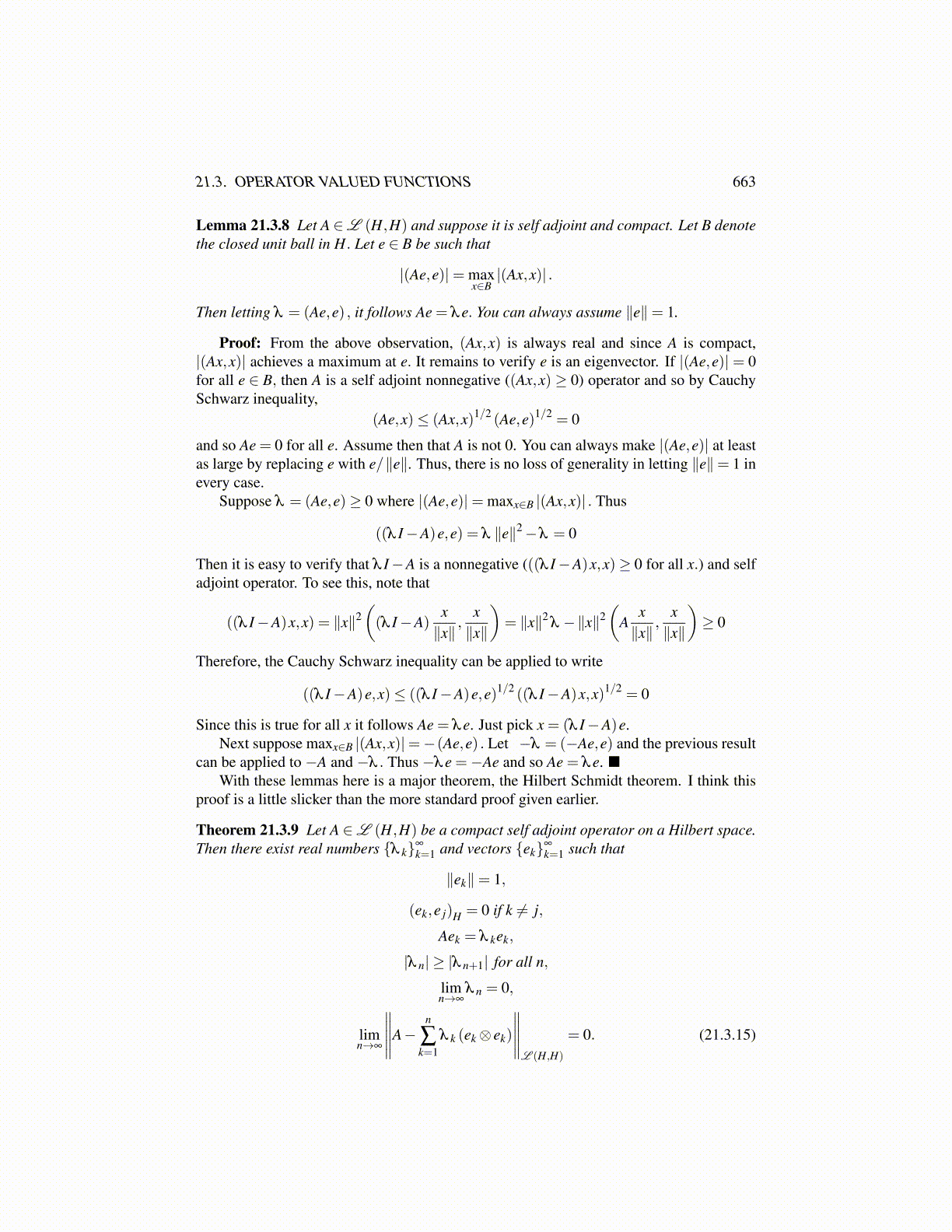
21.3. OPERATOR VALUED FUNCTIONS 663
Lemma 21.3.8 Let A ∈L (H,H) and suppose it is self adjoint and compact. Let B denotethe closed unit ball in H. Let e ∈ B be such that
|(Ae,e)|= maxx∈B|(Ax,x)| .
Then letting λ = (Ae,e) , it follows Ae = λe. You can always assume ∥e∥= 1.
Proof: From the above observation, (Ax,x) is always real and since A is compact,|(Ax,x)| achieves a maximum at e. It remains to verify e is an eigenvector. If |(Ae,e)|= 0for all e ∈ B, then A is a self adjoint nonnegative ((Ax,x) ≥ 0) operator and so by CauchySchwarz inequality,
(Ae,x)≤ (Ax,x)1/2 (Ae,e)1/2 = 0
and so Ae = 0 for all e. Assume then that A is not 0. You can always make |(Ae,e)| at leastas large by replacing e with e/∥e∥. Thus, there is no loss of generality in letting ∥e∥= 1 inevery case.
Suppose λ = (Ae,e)≥ 0 where |(Ae,e)|= maxx∈B |(Ax,x)| . Thus
((λ I−A)e,e) = λ ∥e∥2−λ = 0
Then it is easy to verify that λ I−A is a nonnegative (((λ I−A)x,x)≥ 0 for all x.) and selfadjoint operator. To see this, note that
((λ I−A)x,x) = ∥x∥2((λ I−A)
x∥x∥
,x∥x∥
)= ∥x∥2
λ −∥x∥2(
Ax∥x∥
,x∥x∥
)≥ 0
Therefore, the Cauchy Schwarz inequality can be applied to write
((λ I−A)e,x)≤ ((λ I−A)e,e)1/2 ((λ I−A)x,x)1/2 = 0
Since this is true for all x it follows Ae = λe. Just pick x = (λ I−A)e.Next suppose maxx∈B |(Ax,x)|=−(Ae,e) . Let −λ = (−Ae,e) and the previous result
can be applied to −A and −λ . Thus −λe =−Ae and so Ae = λe.With these lemmas here is a major theorem, the Hilbert Schmidt theorem. I think this
proof is a little slicker than the more standard proof given earlier.
Theorem 21.3.9 Let A ∈L (H,H) be a compact self adjoint operator on a Hilbert space.Then there exist real numbers {λ k}∞
k=1 and vectors {ek}∞
k=1 such that
∥ek∥= 1,
(ek,e j)H = 0 if k ̸= j,
Aek = λ kek,
|λ n| ≥ |λ n+1| for all n,
limn→∞
λ n = 0,
limn→∞
∥∥∥∥∥A−n
∑k=1
λ k (ek⊗ ek)
∥∥∥∥∥L (H,H)
= 0. (21.3.15)